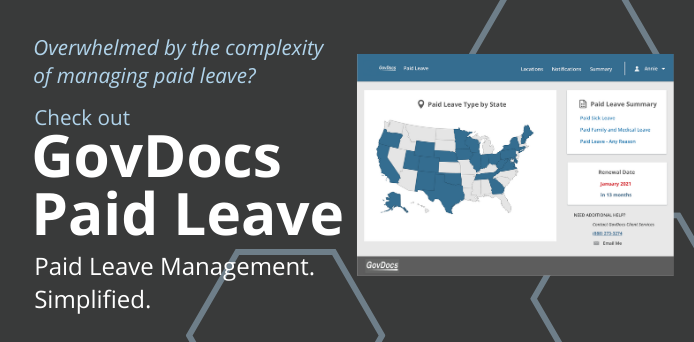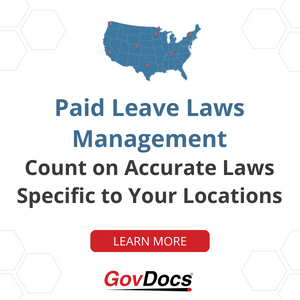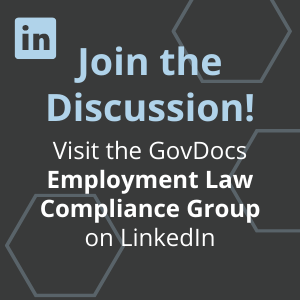EMPLOYMENT LAW NEWS
Minnesota Paid Family and Medical Leave Enacted
By Jana Bjorklund, GovDocs Senior Counsel and Director, Employment Law and Compliance
Published June 7, 2023

There will be rules and potentially FAQs that will be published to provide additional guidance on how employers can comply with Minnesota paid family and medical leave.
A Minnesota paid family and medical leave bill has been signed into law.
The new law will provide up to 20 weeks of paid family and medical leave for covered employees beginning Jan. 1, 2026. (Related: New Minnesota Paid Sick Leave Law)
Meanwhile, a Minnesota Family and Medical Benefit Insurance Division will be created to administer and operate the paid family and medical leave (PFML) benefit program. Employees will apply for PFML benefits through the division rather than their employers. The group will also be responsible for determining whether an employee is eligible for PFML, not their employer.
Paid Leave Management. Simplified.
Minnesota Paid Family and Medical Leave
Under the new Minnesota paid family and medical leave law, there are several items for employers to consider. Here are a few highlights from the new law.
Who is a Covered Employer?
Any individual or business with one or more employees will need to comply with the new Minnesota PFML law. There are no exceptions under the law for small businesses, although there is a premium break for employers with less than 30 employees.
Who is a Covered Employee?
All employees in Minnesota will be eligible for PFML if they have earned at least 5.3 percent of the state average annual wage over their base period, which is defined in the statute as the most recent four completed calendar quarters prior to the employee’s application for PFML benefits.
This is contingent upon the application for PFML benefits having an effective date occurring after the month following the most recently completed calendar quarter.
If the application for PFML benefits has an effective date during the month following the most recent completed calendar quarter, then the base period is the first four of the most recent five completed calendar quarters before the effective date of an applicant’s application for family or medical leave benefits.
How to Manage Paid Leave for Remote and Hybrid Workers
Eligible Reasons for Leave
Employees will be able to take PFML for their own serious health condition, to care for a family member who has a serious health condition, medical care related to pregnancy, baby bonding, safety leave, or for qualifying exigency leave.
Also, a single qualifying event must continue for at least seven consecutive calendar days to be eligible for PFML unless the leave is intermittent.
Family Member Defined under PFML
The definition of a family member under the Minnesota paid family and medical leave law is broader than the definition of a family member under the federal Family and Medical Leave Act.
Employees can use PFML to care for the following:
- Spouse or domestic partner
- Child, including a biological, adopted, or foster child, a stepchild, or a child to whom the applicant stands in loco parentis, is a legal guardian, or is a de facto parent
- Parent or legal guardian of the applicant
- Sibling
- Grandchild
- Grandparent or spouse’s grandparent
- Son-in-law or daughter-in-law
- An individual who has a relationship with the applicant that creates an expectation and reliance that the applicant care for the individual, whether or not the applicant and the individual reside together
Guide: County and City Paid Sick Leave Laws
Amount of Leave Available to Employees
Employees will be eligible for up to 12 weeks of PFML for their own serious health condition and up to 12 weeks of PFML for baby bonding, safety leave, care for a family member, or qualifying exigency.
However, the total amount of PFML an employee may take in one benefit year is 20 weeks.
For example, if an employee takes 10 weeks of PFML for their own serious health condition and then later in the same benefit year needs PFML to care for a family member with a serious health condition, the employee would only have eight weeks left of PFML to care for their family member.
How is PFML Funded?
Minnesota PFML will be funded through quarterly premiums paid into the plan based on the taxable wages of each employee, starting Jan. 1, 2026.
Employers will need to pay at least half of the annual premiums owed. The remainder of premiums will be paid by employees through wage deductions.
The premium rates are dependent upon whether the employer is participating in both family and medical plans or just one or the other.
For an employer participating in both family and medical benefit programs, the premium is 0.7 percent of the employee’s wages. The premium is 0.4 percent of employee’s wages for employers participating in only the medical benefit program and 0.3 percent for an employer participating only in the family benefit program.
Employers opting out of one or both of the PFML programs must have a private plan approved by the Minnesota Family and Medical Benefit Insurance Division. The private plan may be insured or self-insured and must have the same or greater benefits as provided under the state PFML program.
PFML Benefits
In order to receive PFML benefits, employees must apply for family or medical leave benefits through the Minnesota Family and Medical Benefit Insurance Division.
The benefits are paid through the state fund directly — not from the employer. Employees will not receive 100 percent of the weekly wages.
Instead, benefits are subject to a maximum weekly benefit and based on the statute’s calculation.
The applicant’s weekly benefit is calculated by applying the following percentage to their average typical workweek and weekly wage during the high quarter of the base period and adding the sums together (got that?):
- 90 percent of wages that do not exceed 50 percent of the state’s average weekly wage; plus
- 66 percent of wages that exceed 50 percent of the state’s average weekly wage but not 100 percent; plus
- 55 percent of wages that exceed 100 percent of the state’s average weekly wage
Minnesota’s PFML benefits will be prorated for employees who work for wages during leave, use paid sick leave, paid vacation, or other paid time off during leave, or if an employee takes leave intermittently.
Whitepaper: What Employers Need to Know About Paid Leave Laws
Wage Report to be Filed by Employers
Employers will need to submit a quarterly wage detail report to the Minnesota Family and Medical Benefit Insurance Division. They must include the following information for each employee who is employed during the calendar quarter:
- The employee’s name
- Total wages paid to employee
- Total number of paid hours worked
The reports will be due to the commissioner or before the last day of the month following the end of each calendar quarter.
Posting and Notice Requirements for Minnesota Paid Family and Medical Leave
Employers will be required to post in the workplace a notice of PFML benefits.
The poster must be in English and each language other than English that is the primary language of five or more employees of that workplace, if the notice is available in that language from the state.
In addition, employers will need to provide each employee a notice within 30 days of the employee’s start date or 30 days before premium collections begin, whichever is later. The notice must include the following information:
- Explanation of PFML benefits including rights to reinstatement and continuation of health coverage
- Amount of premium deductions made by employer
- Employer’s premium amount and obligations
- Name and address of employer
- Identification number assigned to the employer by state officials
- Instructions on how to file a claim for PFML
- Mailing address, email address, and telephone number of the Minnesota Department of Labor
- Any other information required by the department
Delivery of this notice to employees is considered complete when an employee provides written or electronic acknowledgement of receipt of the information or signs a statement indicating the employee’s refusal to sign such an acknowledgment.
What’s the Difference Between Labor Law Posters and Notices?
What Next?
Employers will have some time to get their ducks in a row to prepare for PFML since benefits and premiums won’t start until Jan. 1, 2026.
In preparation for the new law, employers may want to review their policies and schedule any necessary changes, work with accounting to prepare for premium payments and payroll taxes, and arrange for the necessary changes to the employee’s wage statements.
There will be rules and potentially FAQs that will be published to provide additional guidance on how employers can comply with Minnesota paid family and medical leave.
Stay tuned.
This Employment Law News blog is intended for market awareness only, it is not to be used for legal advice or counsel.
Keep Informed
with GovDocs Employment Law News
Who is GovDocs?
GovDocs simplifies employment law compliance for large employers in the U.S. and Canada. The GovDocs software platform integrates three solutions in one convenient place to help you master the employment laws impacting your business. Whether you manage a labor law posters, minimum wage or paid leave program, our products cut through research time, provide proactive insights into the everchanging landscape of employment laws and reduce the risk of noncompliance. The company is headquartered in Eagan, Minn.
The GovDocs Poster Store simplifies posting compliance for employers with less than 30 locations across all industries, offering a variety of posting products to meet your labor law compliance needs.





